
This research article analyzes the impact of portfolio diversification when applied to a portfolio of stocks and bonds. In particular, it shows that by spreading the investment on uncorrelated asset classes an investor may achieve a higher return per unit of risk taken (Sharpe ratio).
The article is structured as follows. The first section introduces the concept of portfolio diversification through Markowitz Portfolio Theory (MPT). The second section shows how portfolio diversification applies to traditional asset classes like equities and bonds by building an efficient frontier where an investor can choose his desired portfolio in terms of risk and return. The final section analyzes the improvement in the efficient frontier and an existing portfolio by allocating to a hypothetical quant global macro investment strategy investing in all asset classes. The last section concludes with key takeaways.
Modern Portfolio Theory (MPT) was introduced by Harry Markowitz in his 1952’s research paper called “Portfolio Selection”. In substance, it shows that by building a portfolio invested in multiple uncorrelated assets an investor can achieve better returns per unit of risk (Sharpe ratio) due to portfolio diversification. Appendix 1 provides the formulas on how to compute the expected return and volatility of a portfolio.
A simple illustration of the concept is given in the following example, where we consider 2 assets having the same amount of expected return and risk as measured by the volatility of returns for different levels of correlation.
Figure 1 shows the 2 theoretical assets when they are almost perfectly correlated (correlation is 0.93). In this case, they move almost in the same way.

As the figure show, by building a 50-50 portfolio invested equally in the 2 assets does not give any diversification benefit, since the asset move in almost sync.
Figure 2 shows the 50-50 portfolio when the assets are uncorrelated to each other (correlation is 0).

As it can be noticed from the figure, the final portfolio has same expected return, but less risk. This is due to the fact that the assets don’t move perfectly together, offsetting each other at different times during the considered period.
Figure 3 shows the 50-50 portfolio when the 2 assets are inversely correlated (correlation is -1).

As the figure shows, the final portfolio achieves the same return of the initial assets, but it has no risk at all as measured by volatility. This is due to the fact that the noise component of the assets moves exactly opposite to each other, but they still move in an uptrend. This provides final positive returns with no risk.
Table 1 gives the returns and risk stats for the 3 portfolios with varying levels of correlation.

As we can see from it, the lower the correlation between 2 assets, the higher the portfolio diversification benefits in terms of returns per unit of risk taken (Sharpe ratio). For example, in the case of uncorrelated asset, we achieve an increase In Sharpe ratio of 0.18, while in the case of inversely correlated assets we completely eliminate risk, obtaining a volatility of 0.
As the previous example shows, by investing in uncorrelated or inversely correlated assets we can achieve better expected returns per unit of risk or reduce the portfolio risk for the same amount of return. The next section shows this concept and the benefits of portfolio diversification through the efficient frontier
Another way to visualize the benefits of portfolio diversification is by plotting on a chart the amount of risk and expected return of a portfolio. The efficient frontier is given by the combination of portfolios that achieve maximum return for any given risk, for multiple levels of risks considered.
Table 2 shows the risk-return stats of the 2 assets in the following considered examples.

Figure 4 shows the efficient frontier in the case of 2 uncorrelated assets, while Table x shows their performance stats.

As the figure shows, by investing in a portfolio formed by a combination of uncorrelated assets, an investor can achieve better return per unit of risk compared to investing in just a single asset. In this example, an investor who would have invested only in Asset 2 would have achieved 5% return with 6% risk. By investing in a portfolio containing both assets, the investor can for example achieve the around 6.2% return for almost the same level of risk.
Figure 5 shows the Sharpe ratio as a function of the percentage invested in asset 1 in the portfolio.

As the figure shows, there is a portfolio where an investor can achieve a max return per amount of risk taken, the max Sharpe portfolio. In the end, the investor will decide which portfolio to invest in based on how much risk he is willing to assume.
Figure 6 shows the impact of correlation on the efficient frontier. In particular, it shows 3 efficient frontiers in case of perfectly correlated, uncorrelated, and inversely correlated assets.

As we would expect from the results in the previous section and as it can be seen from the figure, by investing in uncorrelated or inversely correlated assets an investor can achieve the same amount of expected return for less risk, or increase the expected return by taking the same risk.
Figure 7 shows the impact of correlation on a portfolio invested equally in the 2 assets.

As we can see from it, the Sharpe ratio increases more than proportionally as correlation decreases. This shows the importance of not keeping all the investment in one asset but on the contrary diversifying a portfolio across multiple uncorrelated assets.
The next section shows an application of portfolio diversification when the 2 considered assets are stocks and bonds.
In this example we apply Modern Portfolio Theory to US stocks and bonds, as represented by the S&P 500 and the Barclays US Aggregate Bond Index respectively.
Figure 8 shows the performance of these 2 assets from October 2003 to December 2018.

Table 3 shows the performance stats of the 2 assets during the considered period.
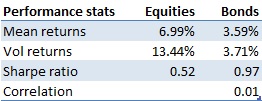
As the table shows, the correlation between the US stocks and bonds for the selected period is almost 0, denoting that the 2 assets have been uncorrelated.
Figure 9 shows the efficient frontier obtained by combining stocks and bonds with different weights in the portfolio.

As the figure shows, since the 2 assets are uncorrelated between each other, an investor who invests in both can get better risk-adjusted returns compared to a pure investment in equities or bonds only. This also shows that US investors, who are usually predominantly invested in the stock market, may obtain higher returns per unit of risk by investing a portion of their portfolio to the bond market.
Figure 10 shows the Sharpe ratio as a function of the percentage of the portfolio invested in stocks.

As the figure shows, during the considered period an investor would have obtained the max Sharpe portfolio by investing 10% in equities and 90% in bond. This portfolio is quite the opposite of the typical US investor portfolio. The max Sharpe portfolio would have achieved a return of 3.93%, with a volatility of 3.61%.
In this section we considered a portfolio of only 2 asset classes, stocks and bonds. In the next section we see whether we can improve our risk-adjusted performance by allocating a portion of our portfolio to a hypothetical quant global macro investment strategy investing globally in all asset classes.
Figure 11 shows the performance of a backtested quantitative global macro investment strategy compared to US stocks and bonds on a log scale.

Table 4 shows the performance stats for the 3 investments.

As both the figure and table show, the quant global macro investment portfolio would have achieved superior risk-adjusted returns for the considered period compared to both equities and bonds.
Figure 12 shows the effect on the efficient frontier by allocating 10% of an existing stock and bond portfolio to the quant global macro investment strategy.

As the figure shows, the efficient frontier with the quant global macro product is superior in terms of returns per unit of risk compared to the stocks and bonds only frontier. In other words, by investing 10% of an existing portfolio to the quant global macro strategy an investor may have achieved higher returns for the same amount of risk, or less risk for the same amount of returns (higher Sharpe ratio).
A contributing factor to this result is the low correlation of the quant global macro strategy to stocks and bonds, as showed by the correlation matrix in Table 5.

Figure 13 shows the efficient frontier for an unconstrained investment in the quant global macro product, stocks, and bonds. This is compared to the 2 previously analyzed efficient frontiers.

As it can be seen from it, the investor could have theoretically achieved higher risk-adjusted returns by investing a higher proportion of his portfolio in the quant global macro investment strategy. This also shows that it is important for an accredited investor to consider an allocation of his portfolio to alternative assets, like quantitative hedge funds, which could provide uncorrelated returns to the equity and bond markets.
In this research we analyzed the benefits of portfolio diversification on an existing portfolio. In particular, we have shown the following:
According to Modern Portfolio Theory, we can quantify the amount of expected return and risk in a portfolio by estimating the return, volatility, and correlation between the assets in the portfolio. The formula for 2 assets is given below

where:
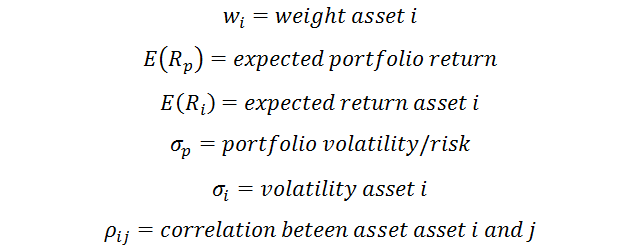
As it can be seen from the formulas, the key inputs determining a portfolio risk and returns are the volatility, returns, and correlations of the underlying assets included in the portfolio.
This research article analyzes the performance of a systematic global macro investment strategy investing in multiple in publicly traded securities across the world. The strategy invests in all asset classes, including Equity, Fixed Income, Commodity, Currencies, and Volatility. The strategy performance is compared to a traditional equity portfolio, represented by the S&P 500, and to a 60/40 portfolio invested in both equities and bonds.
The article is structured as follows. The first section analyzes the performance of equities as represented by the S&P 500. The second section analyzes the performance of a 60/40 portfolio, frequently used as a benchmark for institutional investors. The third section compares the performance of a hypothetical systematic global macro trading strategy compared to a passive investment in the equity market or a 60/40 portfolio. The fourth section concludes with key takeaways.
Figure 1 shows the performance of the S&P 500 from January 1950 until December 2018 on a log scale.

Figure 2 shows the drawdown for a long-term buy and hold strategy in the S&P 500, while Table 1 shows its drawdown statistics.

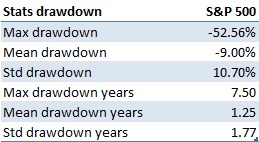
As it can be seen from them, a buy-and-hold investment in the S&P 500 experienced significant drawdowns, with a max drawdown of 52.56%. Some drawdowns were also quite long to recover, with the max drawdown with a length of 7.5 years. This data shows that while it is true that most of the time the equity market goes up, it is also important to try to avoid investing all the money in the stock market since it could take a long time before the investor can recover his losses.
Figure 3 shows the distribution of monthly returns for the S&P 500.

Table 2 shows the performance statistics of a buy-and-hold investment in Bitcoin during the considered period.
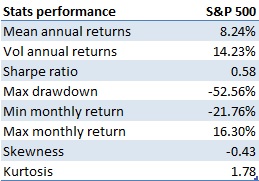
As it can be seen from it, the US equity market provided an average annual return of 8.24% during the period, with a volatility of 14.23%, leading to a Sharpe ratio of 0.58. Also, the return distribution is negatively skewed, due to the presence of small positive returns and large and fast negative returns when a recession or market crash happens.
In summary, investing in the stock market require an investor to have a long-term horizon of at least 5 years, due to the presence of long and big drawdowns. The next section will analyze whether it is possible to improve the performance of a passive equity-only investment by adding bonds to the portfolio.
Figure 4 shows the performance of a static buy-and-hold 60/40 portfolio (60/40) from October 2007 to December 2018. The portfolio invests 60% in the equity market, as represented by the S&P 500 (SPY), and 40% in the bond market, as represented by the Barclays Aggregate Bond Index (AGG). This portfolio is typically held by institutional investors and usually considered a diversified portfolio and used as a benchmark.

Figure 5 shows the drawdown for a long-term buy and hold strategy in the S&P 500, while Table 3 shows its drawdown statistics.

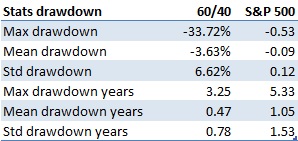
As it can be seen from them, a buy-and-hold investment in the 60/40 ha better drawdowns than the S&P 500, with a max drawdown of 33.72% compared to 52.56% for the S&P 500. The drawdown length also improves, going from a max drawdown of 5.3 year to 3.25, a reduction of around 40%.
Figure 6 shows the distribution of monthly returns for the 60/40 portfolio.

Table 4 shows the performance statistics of a passive buy-and-hold investment in the 60/40 portfolio during the considered period, compared to the S&P 500.
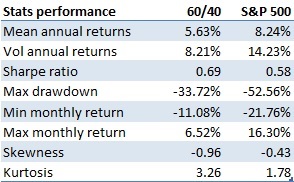
As it can be seen from it, a 60/40 portfolio delivers less return compared to the US equity market, but at the same time is less risky. This delivers in the end a slightly higher Sharpe ratio of 0.69, improving the return per unit of risk taken. This results stems mainly due to portfolio diversification by investing in an uncorrelated asset. In fact, the average correlation between the equity and bond market during the analyzed period is 0.01, indicating that they are uncorrelated. This improves the efficient frontier and provides a better risk-adjusted performance compared a pure equity investment.
In summary, investing in a 60/40 portfolio reduces drawdown width and length and improves the Sharpe ratio, at the expense of less mean annual returns. The next section compares the performance of a 60/40 portfolio and the equity market to an active quantitative global macro investment strategy, to see it the expected performance can be improved.
Figure 7 shows the backtested performance net of transaction costs of a systematic global macro investment strategy from October 2007 to December 2018. The strategy invests in publicly traded securities globally across all asset classes, including Equity, Fixed Income, Commodities, Currencies, and Volatility. The strategy has a fixed target volatility of 15% in order to have risk comparable to an equity market investment as represented by the S&P 500.

Figure 8 shows the drawdown for the systematic global macro investment strategy compared to the S&P 500 and the 60/40 portfolio.

Table 5 shows the drawdown statistics for the 3 investment portfolios. As it can be seen from it and from Figure 8, the portfolio has much lower and faster to recover drawdowns. The max drawdown is in fact 27.79%, almost half compared to 52.56% for the S&P 500. The drawdowns are also faster to recover both on the max and mean measures. The max drawdown length is in fact 2.16 years, compared to 3.25 years for the 60/40 portfolio and 5.3 years for the S&P 500.
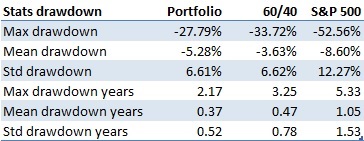
Table 6 shows the performance measures for the 3 strategies. As the table shows, the systematic global macro strategy outperforms both a passive equity market investment and the 60/40 portfolio on both the return and per amount of risk taken. On the return side, it achieves an annual average return of 17.88%, more than double both the S&P 500 at 8.24% and triple the 60/40 portfolio at 5.63%. On the risk side, it has around the same amount of volatility of the equity market per construction. As a result of the better return delivered with around the same amount of risk, the strategy achieves a much better Sharpe ratio of 1.12, compared to 0.58 for the equity market and 0.69 for the 60/40 portfolio. As previously indicated, the max drawdown is also much less and faster to recover.
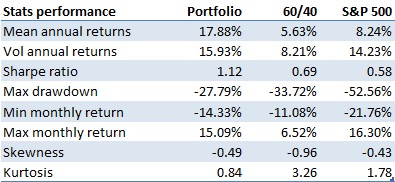
In conclusion, based on the previous results, even after transaction costs the systematic global macro investment strategy proves to be superior both on return and on a per unit of risk basis compared to a passive long-term investment in the S&P 500 and a 60/40 portfolio.
The previous results highlight the following key takeaways: